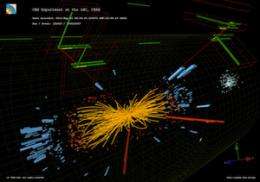Endgame for the Higgs Boson

The last missing piece of scientists’ fundamental model of particle physics is running out of places to hide.
That piece, an elementary particle called the Higgs boson that is thought to give all matter mass, has evaded detection so far. But physicists working at the Large Hadron Collider (LHC) near Geneva, Switzerland, including a contingent of more than two dozen scientists from the University of California, San Diego, have ruled out most of the range of masses the Higgs could have, leaving just a narrow span where the elusive particle might be found.
“If it exists, it has to be there. And if it’s not there, it will be known to be science fiction by December,” Vivek Sharma, a physics professor at UC San Diego told Science NOW. Sharma coordinates the international team searching for Higgs boson with the CMS detector, one of two large instruments deployed in the search. The other is called ATLAS.
By speeding protons around a 27 kilometer ring at nearly the speed of light, then smashing them together, scientists fleetingly recreate conditions that prevailed when the universe began. In those moments the Higgs boson, if it exists, should pop into being and then quickly decay into other more familiar and recognizable particles, which CMS and ATLAS are poised to detect.
In just five months of the LHC running, the two teams have eliminated – at a 95 percent confidence level – most of the range of possible masses the Higgs could have, Sharma reported at the biannual Lepton-Photon conference held recently in Mumbai. “The Higgs, if it exists, is now trapped between 114 and 145 GeV (Giga-electron volts, a measure of mass),” he said.
A Higgs boson within that range would decay in predictable ways. The scientists have observed the kinds of sprays of particles they would expect to see from a Higgs boson, but not often enough to say the events aren’t mere statistical fluctuations of well known background processes.
A definitive interpretation will require more data, which the LHC is starting to deliver. Now back in operation after a pause that has allowed the team to ramp up the rate of collisions, the machine should deliver twice as much data as has accumulated so far by the end of October.
“We are now entering a very exciting phase in the hunt for the Higgs boson,” Sharma said. “If the Higgs boson exists between 114-145 GeV, we should start seeing statistically significant excesses over estimated backgrounds, and if it does not then we hope to rule it out over the entire mass range. One way or the other we are poised for a major discovery, likely by the end of this year.”
Provided by University of California - San Diego


















